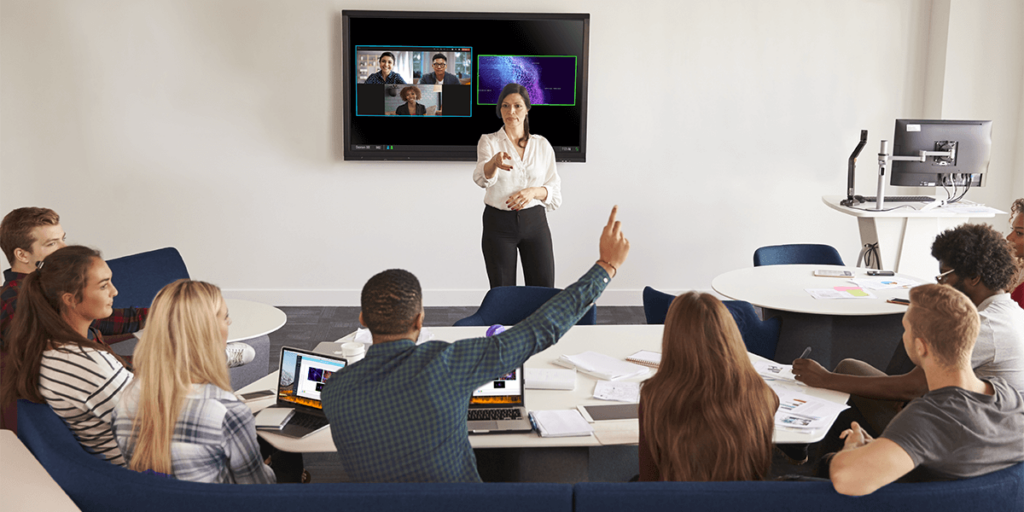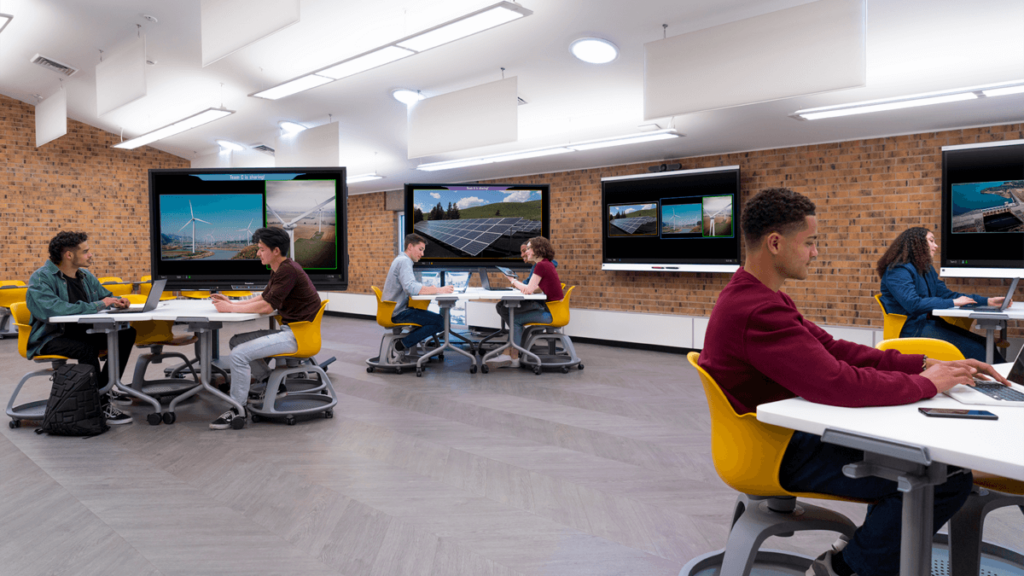While studies have shown that the color of interior walls can have an impact on human psychology, designing learning environments involves a multitude of other factors that are equally important to consider. In today’s fast-paced world, education spaces need to be designed to support the changing needs of learners and educators. The traditional classroom setup with rows of desks and a teacher at the front of the room is no longer sufficient to meet the diverse needs of students. Instead, educational spaces need to be designed to support collaboration, group work, and active learning. In this blog post, we will explore five design tips to transform traditional classrooms into collaborative spaces that foster learning, creativity, and innovation. From flexible furniture to innovative technology, these tips will help educators create learning environments that inspire and engage students.
The physical space in which learning takes place is just as crucial to the educational experience as the material being taught. The environment in which we learn has a significant impact on our ability to learn and retain information. Studies have shown that the physical environment, such as lighting, temperature, and air quality, can affect student motivation, attention span, and overall academic performance. A comfortable environment with proper lighting and temperature control can promote relaxation and create a sense of calm, which can enhance cognitive performance. In addition, the layout of a classroom or educational space can influence the way in which students interact with each other and their teacher. A well-designed environment that supports collaboration and group work can improve student engagement and foster deeper learning. The use of technology, such as interactive displays and multimedia tools, can also enhance the learning experience and increase student participation. The environment in which we learn can have a profound impact on our ability to engage, collaborate, and ultimately succeed in our academic pursuits.

5 Considerations when Designing an Educational Space
1. Flexibility: Instructional areas should be designed to accommodate the changing needs of students and educators. The spaces should be adaptable to different teaching styles, class sizes, and learning modalities.
- Modular furniture can be easily reconfigured to accommodate different lesson plans. Tables and chairs on wheels can be easily moved to create different learning areas, such as small-group workstations or large-group discussion areas.
- Adjustable lighting can create different moods and support different learning activities. Bright lighting can promote focus during individual work, while soft lighting can create a calming atmosphere during group discussions.
- Movable walls can be used to create flexible learning spaces that can be adapted to different class sizes and activities. Classrooms can be divided into smaller learning pods for group work or opened up to create a larger collaborative learning space.
- Outdoor learning spaces can provide a change of scenery and support different learning modalities, such as hands-on and experiential learning. Outdoor classrooms, gardens, and nature trails can be used to teach science, environmental studies, and other subjects.
2. Technology: The integration of technology in education spaces is essential for today’s digital age and for preparing students to enter a digital workforce. Spaces should be designed to support technology infrastructure, such as high-speed internet, smartboards, and multimedia systems.
- Educational facilities should be designed to support high-speed internet connectivity to enable students and teachers to access online resources and collaborate with others in real-time. This includes ensuring that there is sufficient bandwidth to support multiple users and devices.
- Interactive displays, such as smartboards, touchscreens, and interactive whiteboards, can enhance the learning experience by providing a more engaging and interactive way of presenting information. These tools can be used to facilitate class discussions, present multimedia content, and support student collaboration.
- Educational spaces should be designed to support multimedia systems, such as audiovisual equipment and sound systems. These tools can be used to support different learning modalities, such as visual and auditory learning, and can enhance the overall learning experience.
- With the proliferation of mobile devices, educational spaces should be designed to support BYOD policies, which allow students to use their own devices for learning activities. This includes ensuring that there are sufficient power outlets, charging stations, and wireless connectivity.
- Instructional areas can be designed to support virtual and augmented reality technologies, which can create immersive learning experiences. Virtual reality simulations can be used to teach science, history, and other subjects, while augmented reality tools can be used to provide interactive and engaging learning experiences.

3. Safety and Security: Safety and security are paramount in educational spaces. Designers should consider the safety and security features of the space, such as emergency exits, fire suppression systems, and security cameras.
- Clearly marked emergency exits that are easily accessible in case of a fire or other emergency are vital. The exits should be wide enough to accommodate large numbers of people and should be equipped with panic bars to allow for quick and easy exits.
- Academic spaces should be equipped with fire suppression systems, such as sprinklers, to minimize the risk of fire and protect occupants in the event of a fire. Fire extinguishers should also be readily available and clearly marked throughout the space.
- Security cameras to monitor activity can provide an additional layer of security. Cameras can be used to deter theft and vandalism, as well as provide evidence in the event of an incident.
- Access control systems, such as key cards or biometric scanners, can be used to control access to the space and ensure that only authorized individuals are allowed entry. This can help prevent unauthorized individuals from entering and potentially causing harm.
- Campuses should have clear lockdown procedures in place in the event of an active shooter or other security threat. These procedures should be communicated to students and staff and should be regularly practiced to ensure that everyone knows what to do in case of an emergency.
4. Comfort: When designing learning environments, comfort should be a top priority. Since students spend a considerable amount of time in these spaces, it’s crucial to consider factors like lighting, air quality, and temperature control. By ensuring that these elements are optimized, students will be better able to focus and engage in the learning process.
- Academic spaces should be designed to maximize the use of natural lighting, as this has been shown to improve mood and productivity. This can be achieved by incorporating large windows or skylights or using light-reflecting surfaces to distribute natural light throughout the space.
- Educational spaces should have adequate ventilation to ensure that the air is clean and fresh. This can be achieved through the use of air conditioning and filtration systems, or by incorporating natural ventilation through the use of windows or vents.
- Instructional areas should be designed to maintain a comfortable temperature throughout the year. This can be achieved through the use of heating and cooling systems, or by incorporating features such as insulation and shading to regulate the temperature.
- Spaces should be equipped with ergonomic furniture that promotes good posture and reduces the risk of back pain and other musculoskeletal disorders. This can include adjustable desks and chairs, as well as other ergonomic features such as footrests and back supports.
- Classroom settings should be designed to minimize noise and provide a quiet and peaceful environment for learning. This can be achieved through the use of acoustic ceiling tiles, wall panels, and flooring materials, as well as by incorporating noise-reducing features such as sound-absorbing curtains or partitions.
5. Collaboration: Collaboration is an important aspect of education, and educational spaces should be designed to encourage collaboration among students and educators. The spaces should provide opportunities for group work, project-based learning, and interactive discussions.
- Educational spaces should have areas designated for collaborative work, such as group workstations or project rooms. These spaces should be designed to accommodate different group sizes and be equipped with flexible furniture that can be easily rearranged to facilitate collaboration.
- Learning spaces should be equipped with interactive technology, such as smart boards and video conferencing equipment, to enable remote collaboration and encourage interactive discussions.
- Classroom settings should be designed with open layouts that promote freedom for communication and collaboration. This can be achieved through the use of open spaces, flexible seating arrangements, and the use of glass walls to visually connect different areas of the space.
- Instructional areas should have breakout spaces where students can work on individual or small-group projects. These spaces should be designed to be comfortable and flexible, with a range of seating options and adaptable furniture.
Designing educational spaces that promote collaboration, creativity, and innovation is essential in today’s rapidly changing world. By considering factors such as flexibility, technology, safety and security, comfort, and collaboration, educators can create learning environments that inspire and engage students. Investing in the design and setup of educational spaces can have a significant impact on student motivation, academic performance, and overall success. As educators continue to adapt to new teaching and learning styles, it is important to keep in mind the role that the physical environment plays in supporting student success. By designing innovative, flexible, and collaborative learning spaces, educators can provide students with the tools they need to succeed in their academic pursuits and prepare them for their future.
Want to learn more about how Solstice can be implemented in your education spaces? Reach out to get a product demo.
